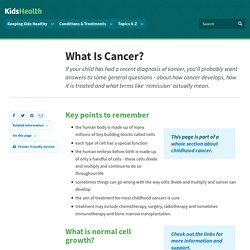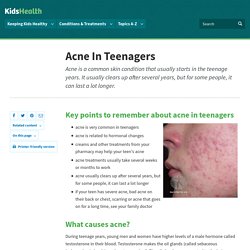

What is An Eating Disorder & The Affects on Mental Health. What Is Cancer? Key points to remember the human body is made up of many millions of tiny building blocks called cells each type of cell has a special function the human embryo before birth is made up of only a handful of cells - these cells divide and multiply and continue to do so throughout life sometimes things can go wrong with the way cells divide and multiply and cancer can develop the aim of treatment for most childhood cancers is cure treatment may include chemotherapy, surgery, radiotherapy and sometimes immunotherapy and bone marrow transplantation What is normal cell growth?

Every human body has millions of cells The human body is made up of many millions of tiny building blocks called cells. Each organ of the body (for example, kidney, muscle) contains its own special types of cells. Kidney cells get rid of waste products muscle cells move a joint Every cell has a central part called the nucleus containing DNA, chromosomes and genes. Acne In Teenagers. Key points to remember about acne in teenagers acne is very common in teenagersacne is related to hormonal changescreams and other treatments from your pharmacy may help your teen's acneacne treatments usually take several weeks or months to workacne usually clears up after several years, but for some people, it can last a lot longerif your teen has severe acne, bad acne on their back or chest, scarring or acne that goes on for a long time, see your family doctor What causes acne?

During teenage years, young men and women have higher levels of a male hormone called testosterone in their blood. Testosterone makes the oil glands (called sebaceous (seb-ay-shus) glands) produce too much oil. The oil glands are connected to the hair follicles on your teen's face, neck, chest and back. What are the different types of acne? Whiteheads Whiteheads are round, white blemishes that form when plugs of oil and dead skin cells block hair follicles. Blackheads Pimples Deep cysts. Diabetes In Children - An Overview. Key points to remember about diabetes in children Diabetes happens when the level of glucose in the blood is too high. diabetes is a condition where the level of glucose in the blood is too high that's because the body is not using the glucose properly in type 1 diabetes, the main problem is that the insulin-making cells in the pancreas are destroyed and not able to make enough insulin in type 2 diabetes, the main problem is that the body is not able to use the insulin effectively due to resistance to insulin both forms of diabetes are lifelong conditions - once diagnosed as having type 1 or type 2 diabetes, your child will always have it you can minimise the long-term risks and complications for your child.

Type 2 Diabetes in Children & Adolescents. Introduction Type 2 diabetes was previously seen only in middle age or older adults.

However, with the rise of obesity in children, it is now being increasingly diagnosed in young people, particularly Aboriginal and Torres Strait Islander youth and children with non- European backgrounds. Type 2 diabetes is serious and can cause long-term complications such as heart and kidney disease, which, with more young people developing type 2 diabetes, are likely to occur at a younger age. Proper treatment is therefore essential to preventing these long-term health problems.
Australia Has One Of The Highest Food Allergy Rates In The World—What’s Going On? When I was growing up, peanut butter was still allowed in school lunch boxes and soggy egg sandwiches were the norm.

You knew what an EpiPen was but never really came across one and ‘anaphylaxis’ was just a word you couldn’t pronounce. Fast forward 20 or so years and it seems as though everywhere you turn, you know of a child (or adult) with a food allergy. Differing greatly to ‘a food intolerance’, a food allergy is a serious, life-threatening condition—and one that’s developing at a rapid rate. Why are food allergies so prominent nowadays? Alarmingly, statistics show that 1 in 10 babies born in Australia today will develop a food allergy—and despite considerable research being carried out in this area, Maria Said, CEO of Allergy & Anaphylaxis Australia, says there is little definitive knowledge as to why they are on the rise. “Genetic factors can also increase the likelihood of a child developing an allergy,” Said tells Sporteluxe. Kidshealth. Key points to remember about allergy allergies happen when your child's immune system overreacts to a substance (called an allergen) which is harmless to most peopleevery time your child has contact with that allergen they will experience symptoms of an allergic reaction, usually within a few minutesenvironmental/airborne allergens (such as house dust mites, pollen and pets) can cause mild to moderate symptomsfood allergy (and also bee or wasp venom, and latex) can cause mild to severe symptomsanaphylaxis is a life-threatening allergic reaction which requires urgent medical treatment What is an allergy?

An allergy occurs when a person's immune system overreacts to a substance (allergen) in the environment by making allergic antibodies (IgE) against the allergen. There are many types of allergens found in our environment. The most common of these are: airborne allergens that come from dust mites, cats and dogs, pollen, mouldsfood allergensinsect venomother things such as drugs or latex.